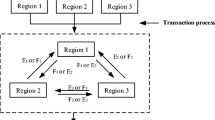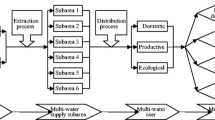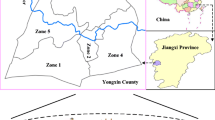Abstract
In this study, a Bayesian-based two-stage inexact optimization (BTIO) method is developed for supporting water quality management through coupling Bayesian analysis with interval two-stage stochastic programming (ITSP). The BTIO method is capable of addressing uncertainties caused by insufficient inputs in water quality model as well as uncertainties expressed as probabilistic distributions and interval numbers. The BTIO method is applied to a real case of water quality management for the Xiangxi River basin in the Three Gorges Reservoir region to seek optimal water quality management schemes under various uncertainties. Interval solutions for production patterns under a range of probabilistic water quality constraints have been generated. Results obtained demonstrate compromises between the system benefit and the system failure risk due to inherent uncertainties that exist in various system components. Moreover, information about pollutant emission is accomplished, which would help managers to adjust production patterns of regional industry and local policies considering interactions of water quality requirement, economic benefit, and industry structure.










Similar content being viewed by others
References
Ahmadi A, Moridi A, Han D (2015) Uncertainty assessment in environmental risk through Bayesian networks. J Environ Inform 25(1):46–59
Ahmed EA (2014) Bayesian estimation based on progressive Type-II censoring from two-parameter bathtub-shaped lifetime model: an Markov chain Monte Carlo approach. J Appl Stat 41(4):752–768
Assumaning GA, Chang SY (2014) State and parameter estimation in three-dimensional subsurface contaminant transport modeling using Kalman Filter coupled with Monte Carlo sampling. J Environ Inform 24(2):80–89
Ball JE, Jenks R, Aubourg D (1998) An assessment of the availability of pollutant constituents onroad surfaces. Sci Total Environ 209:243–254
Beck MB (1987) Water quality modeling: a review of the analysis of uncertainty. Water Resour Res 23(8):1393–1442
Birge JR, Louveaux FV (1988) A multicut algorithm for two-stage stochastic linear programs. Eur J Oper Res 34:384–392
Borsuk ME, Higdon D, Stow CA, Reckhow KH (2001) A Bayesian hierarchical model to predict benthic oxygen demand from organic matter loading in estuaries and coastal zones. Ecol Model 143:165–181
Chen DJ, Dahlgren RA, Shen YN, Lu J (2012) A Bayesian approach for calculating variable total maximum daily loads and uncertainty assessment. Sci Total Environ 430:59–67
Debaje SB (2014) Estimated crop yield losses due to surface ozone exposure and economic damage in India. Environ Sci Pollut Res 21(12):7329–7338
Du P, Li YP, Huang GH (2013) Inexact chance-constrained waste-load allocation model for water quality management of Xiangxihe River. J Environ Eng 139:1178–1197
Freni G, Mannina G (2010) Bayesian approach for uncertainty quantification in water quality modelling: the influence of prior distribution. J Hydrol 392:31–39
Fu CY, Fang T, Deng NS (2006) The research of phosphorus of Xiangxi River nearby the Three Gorges, China. Environ Geol 49(6):923–928
Fujiwara O, Puangmaha W, Hanaki K (1988) River basin water quality management in stochastic environment. J Environ Eng 114(4):864–877
Gajewska M, Jóźwiakowski K, Ghrabi A, Masi F (2015) Impact of influent wastewater quality on nitrogen removal rates in multistage treatment wetlands. Environ Sci Pollut Res 22(17):12840–12848
Gilks WR, Richardson S, Spiegelhalter DJ (1996) Introducing Markov Chain Monte Carlo. Int Stat 91(8):1–19
Gill J (2002) Bayesian methods: a social and behavioral sciences approach. Chapman & Hall, London, CRC Press, Boca Raton, FL
Gimenez O, Bonner SJ, King R, Parker RA, Brooks SP, Jamieson LE, Grosbois V, Morgan BJT, Thomas, L (2009) WinBUGS for population ecologists: Bayesian modeling using Markov chain Monte Carlo methods. Environ Ecol Stat 3:883–915
Giudici P, Givens GH, Mallick BK (2009) Bayesian modeling using WinBUGS. Wiley, New York
Huang GH, Loucks DP (2000) An inexact two-stage stochastic programming model for water resources management under uncertainty. Civ Eng Environ Syst 17:95–118
Huang YL, Huang GH, Liu DF, Zhu H, Sun W (2012) Simulation-based inexact chance-constrained nonlinear programming for eutrophication management in the Xiangxi Bay of Three Gorges Reservoir. J Environ Manag 108:54–65
Jordan YC, Ghulam A, Chu ML (2014) Assessing the impacts of future urban development patterns and climate changes on total suspended sediment loading in surface waters using geoinformatics. J Environ Inform 24(2):65–79
Li YP, Huang GH (2009) Two-stage planning for sustainable water quality management under uncertainty. J Environ Manag 90(8):2402–2413
Li YP, Huang GH (2012) A recourse-based nonlinear programming model for stream water quality management. Stoch Env Res Risk A 26:207–223
Li YP, Li W, Huang GH (2012) Two-stage inexact-probabilistic programming model for water quality management. Environ Eng Sci 29(7):713–725
Li J, Yang WJ, Jin ZW (2014) A three dimensional particle tracking model for simulation of Xiangxi River algal bloom process. Acta Sci Circumst 34(2):481–487 (in Chinese)
Liu Y, Yang PJ, Hu C, Guo HC (2008) Water quality modeling for load reduction under uncertainty: a Bayesian approach. Water Resour 42:3305–3314
Lund JR (2002) Floodplain planning with risk-based optimization. J Water Resour Plan Manag ASCE 128(3):202–207
Lung WS, Sobeck J, Robert G (1999) Renewed use of BOD/DO models in water-quality management. J Water Resour Plan Manag 125:222–230
Lunn DJ, Thomas A, Best N, Spiegelhalter D (2000) WinBUGS—a Bayesian modelling framework: concepts, structure, and extensibility. Stat Comput 10:325–337
Malve O, Qian SS (2006) Estimating nutrients and chlorophyll a relationships in Finnish lakes. Environ Sci Technol 40:7848–7853
Mujumdar PP, Saxena P (2004) A stochastic dynamic programming model for stream water quality management. Sadhana 29:477–497
Nasiri F, Savage T, Wang RR, Barawid N, Zimmerman JB (2013) A system dynamics approach for urban water reuse planning: a case study from the Great Lakes region. Stoch Env Res Risk A 27:675–691
Ouyang L, Zhuge YS, Liu DF (2008) Research on water environment capacity of the Xiangxi Bay in the Three Gorges Reservoir Region. Yangzte River 39:12–4 (in Chinese)
Peng H, Yao W, Huang P (2010) Application of modified Streeter-Phelps Model and COD changing model to Xiangxi River in Three Gorges Reservoir Area. Bioinform Biomed Eng 6(18–20):1–4
Qian SS, Reckhow KH, Zhai J, McMahon G (2005) Nonlinear regression modeling of nutrient loads in streams: a Bayesian approach. Water Resour Res 41:1–10
Qin XS, Huang GH (2009) An inexact chance-constrained quadratic programming model for stream water quality management. Water Resour Manag 23:661–695
Qin XS, Huang GH, Chen B, Zhang BY (2009) An interval parameter waste-load-allocation model for river water quality management under uncertainty. Environ Manag 43(6):999–1012
Reckhow KH (1994) Importance of scientific uncertainty in decision-making. Environ Manag 18:161–166
Revelli R, Ridolfi L (2004) Stochastic dynamics of BOD in a stream with random inputs. Adv Water Resour 27:943–952
Schönbrodt-Stitt S, Saumer P, Behrens T, Seeber C, Scholten T (2010) Assessing the USLE crop and management factor C for soil erosion modeling in a large mountainous watershed in Central China. J Earth Sci 21:835–845
Seeber C, Hartmann H, Wei X, King L (2010) Land use change and causes in the Xiangxi catchment, Three Gorges Area derived from multispectral data. J Earth Sci 21:846–855
Shen ZY, Chen L, Liao Q (2015) Effect of rainfall measurement errors on nonpoint-source pollution model uncertainty. J Environ Inform 26(1):14–26
Sluijs JPVD, Amaral-Rogers V et al (2015) Conclusions of the Worldwide Integrated Assessment on the risks of neonicotinoids and fipronil to biodiversity and ecosystem functioning. Environ Sci Pollut Res 22(1):148–154
Statistical Bureau of Xingshan County (2014) Government work report of Xingshan County 2014. China Statistics Press, Beijing (in Chinese)
Stow CA, Cha YK, Qian SS (2014) A Bayesian hierarchical model to guide development and evaluation of substance objectives under the 2012 Great Lakes Water Quality Agreement. J Great Lakes Res 40:49–55
Streeter HW, Phelps EB (1925) A Study of the Pollution and Natural Purification of the Ohio River. US Public Health Service, Public Health Bulletin, No.146, Washington DC
Thomann RV, Mueller JA (1987) Principles of surface water quality modeling and control. Harper &Row Publishers, NewYork
Urbaniak M, Kiedrzyńska E, Zieliński M, Tołoczko W, Zalewski M (2014) Spatial distribution and reduction of PCDD/PCDF toxic equivalents along three shallow lowland reservoirs. Environ Sci Pollut Res 21(6):4441–4452
van Gils IJAG, Argiropoulos D (1991) Axios river basin water quality management. Water Resour Manag 5(3–4):271–280
Yang L, Liu DF, Huang YL, Yang ZJ, Ji DB, Song LX (2015) Isotope analysis of the nutrient supply in Xiangxi Bay of the Three Gorges Reservoir. Ecol Eng 77:65–73
Ye L, Cai QH, Liu RQ, Cai M (2009) The influence of topography and land use on water quality of Xiangxi River in Three Gorges Reservoir region. Environ Geol 58(5):937–942
Zhang JL, Li Y, Huang GH (2013) A robust simulation-optimization modeling system for effluent trading - a case study of nonpoint source pollution control. Environ Sci Pollut Res 21:5036–5053
Zhang N, Li YP, Huang WW, Liu J (2014) An inexact two-stage water quality management model for supporting sustainable development in a rural system. J Environ Inform 24(1):52–64
Acknowledgments
This research was supported by the Major Science and Technology Program for Water Pollution Control and Treatment (2014ZX07104-005-03) and the National Natural Science Foundation for Distinguished Young Scholar (51225904). The authors are grateful to the editors and the anonymous reviewers for their insightful comments and suggestions.
Author information
Authors and Affiliations
Corresponding author
Additional information
Responsible editor: Marcus Schulz
Appendix
Appendix
- i :
-
Number of chemical plant
- j :
-
Number of phosphorus mining company
- s :
-
Number of river segment
- t :
-
Planning period: t = 1 nonflood season and t = 1 flood season
- k :
-
Maximum allowable loading levels: k = 1 low level, k = 2 medium level, and k = 3 high level
- L t :
-
Length of planning period (day)
- CB ± it :
-
Net benefit from chemical plant i in period t (RMB¥/t)
- PB ± jt :
-
Net benefit from phosphorus mining company j in period t (RMB¥/t)
- TB ± st :
-
Net benefit from town water supply on segment s in period t (RMB¥/m3)
- AB ± st :
-
Net benefit from agricultural zone on segment s in period t (RMB¥/ha)
- LB ± st :
-
Net benefit from livestock husbandry on segment s in period t (RMB¥/unit of equivalent pig)
- RB ± st :
-
Net benefit from rural water supply on segment s in period t (RMB¥/m3)
- X ± it :
-
Production level of chemical plant i in period t (t/day)
- P ± jt :
-
Production level of phosphorus mining company j in period t (t/day)
- WT ± st :
-
Production level of town water supply on segment s in period t (m3/day)
- Z ± st :
-
Planting area of agricultural zone on segment s in period t (ha/t)
- Y ± st :
-
Equivalent pig number of livestock husbandry on segment s in period t (t−1)
- WR ± st :
-
Production level of rural water supply on segment s in period t (m3/day)
- p kt :
-
Probability of maximum allowable loading levels in period t
- CC ± it :
-
Economic penalty when the predefined pollutant load targets for chemical plant i in period t are not met (RMB¥/t)
- CP ± jt :
-
Economic penalty when the predefined pollutant load targets for phosphorus mining company j in period t are not met (RMB¥/t)
- CT ± st :
-
Economic penalty when the predefined pollutant load targets for town water supply on segment s in period t are not met (RMB¥/m3)
- CA ± st :
-
Economic penalty when the predefined pollutant load targets for agricultural zone on segment s in period t are not met (RMB¥/ha)
- CL ± st :
-
Economic penalty when the predefined pollutant load targets for livestock husbandry on segment s in period t are not met (RMB¥/unit of equivalent pig)
- CR ± st :
-
Economic penalty when the predefined pollutant load targets for rural water supply on segment s in period t are not met (RMB¥/m3)
- XD ± ikt :
-
The production amount of chemical plant i by which production target is not met when the probability of maximum loading level is k (t/day)
- PD ± jkt :
-
The production amount of phosphorus mining company j by which production target is not met when the probability of maximum loading level is k (t/day)
- TD ± skt :
-
The amount by which town water supply target is not met when the probability of maximum loading level is k (m3/day)
- AD ± skt :
-
The amount by which planting area target is not met when the probability of maximum loading level is k (ha/t)
- LD ± skt :
-
The amount by which livestock husbandry target is not met when the probability of maximum loading level is k (t−1)
- RD ± skt :
-
The amount by which rural water supply target is not met when the probability of maximum loading level is k (m3/day)
- CLP ± it :
-
TP load of per unit production from chemical plant i in period t (t/t)
- PLP ± jt :
-
TP load of per unit production from phosphorus mining company j in period t (t/t)
- TLP ± st :
-
TP load of per m3 wastewater from urban sewage treatment plant on segment s in period t (t/m3)
- ALP ± st :
-
TP load of per ha cropped land from agricultural zone on segment s in period t (t/ ha)
- LLP ± st :
-
TP load of per equivalent pig from livestock husbandry on segment s in period t (t)
- RLP ± st :
-
TP load of per m3 rural wastewater from rural life on segment s in period t (t/m3)
- CLO ± it :
-
COD load of per unit production from chemical plant i in period t (t/t)
- PLO ± jt :
-
COD load of per unit production from phosphorus mining company j in period t (t/t)
- TLO ± st :
-
COD load of per m3 wastewater from urban sewage treatment plant on segment s in period t (t/m3)
- ALO ± st :
-
COD load of per ha cropped land from agricultural zone on segment s in period t (t/ha)
- LLO ± st :
-
COD load of per equivalent pig from livestock husbandry on segment s in period t (t)
- RLO ± st :
-
COD load of per m3 rural wastewater from rural life on segment s in period t (t/ m3)
- RTW ± st :
-
Generation rate of urban wastewater on segment s in period t (m3/m3)
- RRW ± st :
-
Generation rate of rural wastewater on segment s in period t (m3/m3)
- ω ± st :
-
Proportion of agricultural effluent discharged into the river on segment s in period t (%)
- η ± st :
-
Proportion of livestock husbandry effluent discharged into the river on segment s in period t (%)
- δ ± st :
-
Proportion of rural life effluent discharged into the river on segment s in period t (%)
- MALP ± skt :
-
Maximum allowable loading of TP with probability k on segment s in period t (t)
- MALO ± skt :
-
Maximum allowable loading of COD with probability k on segment s in period t (t)
- SL ± st :
-
Average soil loss from agricultural zone on segment s in period t (t/ha)
- ML ± st :
-
Maximum allowable soil loss agricultural zone on segment s in period t (t/ha)
- X min i , X max i :
-
The minimum and maximum production amount of chemical plant i (t/day).
- P min j , P max j :
-
The minimum and maximum production amount of phosphorus mining company j (t/day)
- WT min st , WT max st :
-
The minimum and maximum amount of town water supply on segment s in period t (m3/day)
- WR min st , WR max st :
-
The minimum and maximum amount of rural water supply on segment s in period t (m3/day)
- Y min st , Y max st :
-
The minimum and maximum amount of equivalent pig on segment s in period t
- Z min st , Z max st :
-
The minimum and maximum cropped area on segment s in period t (ha)
- TS ±min , TS ±max :
-
The minimum and maximum treatment amount of urban sewage treatment plant on segment s in period t (m3/day)
Rights and permissions
About this article
Cite this article
Hu, X.H., Li, Y.P., Huang, G.H. et al. A Bayesian-based two-stage inexact optimization method for supporting stream water quality management in the Three Gorges Reservoir region. Environ Sci Pollut Res 23, 9164–9182 (2016). https://doi.org/10.1007/s11356-016-6106-6
Received:
Accepted:
Published:
Issue Date:
DOI: https://doi.org/10.1007/s11356-016-6106-6




